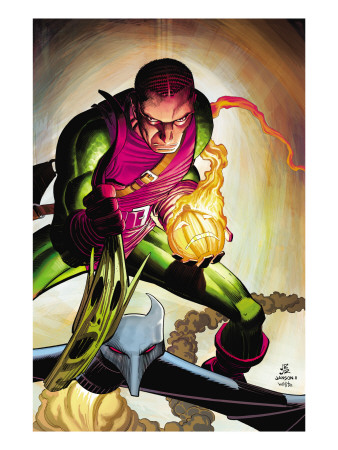
Amazing Spider-Man #14, July 1964
Nicknames and Aliases
The Green Goblin, Iron Patriot
Powers and Abilities
Norman possess superhuman strength, stamina, and healing abilities as a result of the Goblin serum, a chemical compound of his own design. He also possesses genius-level intelligence and business/leadership acumen, as well as an aptitude for chemical and electrical engineering.
Recently, AIM scientists gave Norman powers similar to that of the Super-Adaptoid, enabling him to absorb the super-human abilities of anyone he physically touches.
Gadgets and Accessories
As the Green Goblin, Norman routinely uses explosive and gaseous pumpkin bombs of his own design, and rides a flying “Goblin Glider” with an assortment of offensive capabilities.
As the Iron Patriot, Norman wore a suit of sophisticated armor similar to Iron Man’s, outfitted with an array of weaponry.
Friends and Allies
Harry Osborn (his son), Liz Allen-Osborn (his daughter-in-law), Normie Osborn (his grandson), Dark Avengers, the Cabal, HAMMER, Thunderbolts
Foes and Antagonists
Spider-Man (Peter Parker), Ben Reilly (Peter’s clone), sanity, J. Jonah Jameson, the Avengers, SHIELD.
Movies and Multimedia Appearances
As the Green Goblin, Norman as appeared in nearly every adaptation that Spider-Man has, including the 1967 animated series, Spider-Man and His Amazing Friends, and Fox’s 90s series.
On film, Norman was played by Willem Dafoe in the Sam Raimi films, while Chris Cooper takes on the role in Marc Webb’s Amazing Spider-Man 2.
One Sentence Origin
After ingesting a serum which granted him super-human abilities along with mental instability, industrialist Norman Osborn adopted the mantle of the Green Goblin and began terrorizing the people of New York.
Memorable Moment
Amazing Spider-Man #122: Having killed Spider-Man’s girlfriend, Gwen Stacy, Norman is seemingly killed by his own goblin glider after Spider-Man dodges the attack.
Austin’s Analysis
The history of Norman Osborn is the history of two almost completely different characters. Introduced about mid-way through Stan Lee and Steve Ditko’s seminal run on Amazing Spider-Man, Norman Osborn, as the Green Goblin (the name/identity came later), was a fairly routine crime lord character, one who hoped to unite all the various pieces of the underworld into a single organization under his control (one of several such characters at the time with that ambition). He was relatively unique for his gimmick (the goblin costume and paraphernalia) and for having a mysterious secret identity unknown to the reader (though he was certainly not the only Spidey villain in that situation). But he really stood out from the pack once that identity, of Norman Osborn, father to Peter Parker’s college chum Harry, was revealed, while at the same Norman learned Spider-Man’s true identity. Thus, the battles between the Green Goblin and Spider-Man gained a personal, unique edge that informed all their subsequent encounters (various bouts of amnesia on Norman’s part prevented him from blowing Peter’s secret wide open).
Then came the most significant event of Norman’s villainous career as, in a moment some comics historians cite as the end of the Silver Age of comics, Norman killed Gwen Stacy, Spider-Man’s girlfriend. In the next issue, Norman himself died, impaled through the chest by his own Goblin Glider after Spider-Man dodged the attack. The legacy of the Green Goblin would continue, carried on by Harry and others, including the Hobgoblin, a villain inspired by Norman who was at the center of one of the bigger Spider-Man mysteries during the 80s. But Norman himself was dead, his story over. Or so it seemed.
Flashforward to the mid-90s. The Spider-Man books (now several of them) are mired in the infamous “Clone Saga”, a sprawling, long running storyline that was trying the patience of more than a few fans. For the climax of the story, Norman Osborn returns, his death retconned (he essentially got better, then went to Europe), and he is credited as having orchestrated the entire Clone Saga from behind the scenes, an elaborate revenge scheme on Spider-Man. And with that, the second iteration of Norman Osborn, that of a behind-the-scenes power player, less a Silver Age costumed criminal and more a Kingpin or modern Lex Luthor. Though Norman would continue to don the attire of the Green Goblin from this point forward, more and more often his greatest acts of villainy were carried out simply as Norman.
Not only that, but this iteration of Norman rose to such prominence that he broke out of the Spider-Man rogues gallery, becoming a major player in the Marvel Universe. Over the course of Marvel event storylines such as Civil War, Dark Reign, and Secret Invasion, Norman increased and consolidated his power until he was put in charge of SHIELD, re-branding it as HAMMER and starting a dark rule over the Marvel Universe. For several years, Norman Osborn was the chief antagonist of Marvel’s heroes, whether orchestrating events behind-the-scenes, or leading his own team of psychopathic Avengers.
Norman’s insanity and villainous motivations eventually came to light, and he was stripped of his power. In the intervening years, Norman has remained a thorn in the side of not only Spider-Man, but the larger Marvel Universe as well. From his relatively humble origins as a Spider-Man villain-du-jour, he has grown, from one of Spider-Man’s defining antagonists, to the founder of a villainous legacy that continues to plague Spidey, to a character on the level of Dr. Doom, capable of causing trouble for numerous heroes across multiple titles.







